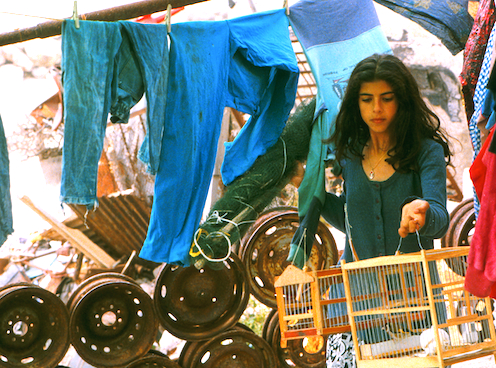Although Elia Suleiman’s film Divine Intervention (2002) lacks physical words, a series of vignettes portray the absurd, comical, and tragic events of the West Bank, conjuring Palestine’s traumatized identity in its structure (Ball, 2). The film’s entire plot, like its individual episodes, revolves around a common theme, which imparts a more coherent structure (Gertz & Khleifi 187). The individual stories of a variety of citizens that shows the severity of the Israeli-Palestinian conflict and just how the conflict affects the citizens of Palestine. The daily actions and routines of the Palestinians reflect just how the Israeli-Palestinian conflict creates an seemingly unbreakable barrier for the Palestinians, as well as show their sheer boredom and internal conflict among the Palestinians.
Released in 2002, Divine Intervention falls under the time frame of the second intifada. If the film is historically accurate to what was going on, then the whole movie would be an allusion to the second intifada. The second intifada was a time of high tension between the Palestinians and the Arabs. Divine Intervention uses the repetitive, seemingly useless actions, that appear as if they come from sheer boredom, to emphasize the point that the Palestinians feel as if their lives are boring and meaningless. The tensions between the Palestinians themselves is shown during the scene where the man is driving down the street, appearing pleasant, but mumbling profanities to himself. This scene in particular shows the underlying hostility throughout the Palestinian population, while maintaining a façade for how the people truly feel. The high-tensions are relatively prevalent throughout the movie, as seen in the scene where the grenade is thrown at the tanks, and the confrontation of the two neighbors where one of them continually throws trash on their front lawn. The Palestinian-Palestinian tensions are mirrored through Palestinian-Israeli tension and are shown in the scene where the Israeli and Palestinian drivers lock eyes. The high-strung conflict is consistently portrayed throughout the film, but those are just a few examples of how it is shown in Divine Intervention.

The arbitrary storyline in Divine Intervention could classify the movie as abstract; one where the metaphors and meanings behind the actions speaks louder than the storyline itself. Suleiman uses repetitive actions on a daily basis to emphasize the fact that the Israeli oppression has pretty much immobilized the Palestinian population to a point where the actions become meaningless. One example in particular that is very powerful is where E.S. sits at the checkpoint for hours on end. Suleiman chose to use this scene in particular as much as he did to represent the border as a barrier blocking the Palestinians from freedom. The amount of time that E.S. spends there shows his serious desire for the freedom that seems unattainable. At the same time, the presence of the checkpoint is resisted through a highly controlled film image, where the love story between E.S. and his West Bank girlfriend takes precedence over the inhumanity and cruelty of the checkpoint (Abu-Remaileh 13). The romance of two people is placed center-stage in the plot, while the political reality of the Oslo Accords are cast as a mere ruse to distract the occupying Israeli state and allow the lovers to consummate their love (Salti 47).
Suleiman does an excellent job of representing the barrier the Israelis established and the tension between the Palestinians themselves. Regardless of the serious conflict that the movie touches upon, Suleiman succeeds in portraying the Palestinian lifestyle in a comical manner, making watching the movie as a whole more enjoyable than it already is.
Works Cited
Abu-Remaileh, Refqa. Palestinian Anti-narratives in the Films of Elia Suleiman
(2008): n. pag. Arab Media & Society. May 2008. Web. 25 Feb. 2017.
Ball, Anna. “Between a Postcolonial Nation and Fantasies of the Feminine: The
Contested Visions of Palestinian Cinema.” Duke University Press. N.p., 01 Jan.
1970. Web. 24 Feb. 2017.
Divine Intervention. Dir. Elia Suleiman. Perf. Elia Suleiman and Manal Khader.
Seville Pictures, 2002. DVD.
Gertz, Nurith, and Khleifi, George. “A Chronicle of Palestinian Cinema.” Film in
the Middle East and North Africa: Creative Dissidence (2011): 187-197.
Salti, Rasha. “From Resistance and Bearing Witness to the Power of the
Fantastical: Icons and Symbols in Palestinian Poetry and Cinema.” Third Text.
N.p., 29 Jan. 2010. Web. 25 Feb. 2017.






